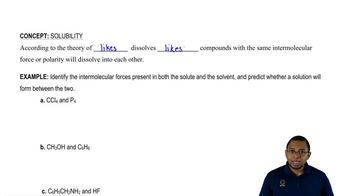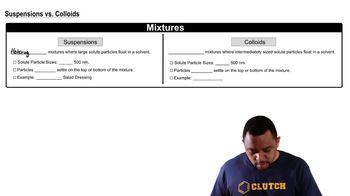Here are the essential concepts you must grasp in order to answer the question correctly.
Heterogeneous Mixtures
Heterogeneous mixtures are composed of different components that can be visually distinguished and are not uniformly distributed. In these mixtures, the individual substances retain their own properties and can often be separated by physical means. An example is a salad, where the ingredients remain distinct.
Recommended video:
Solubility and Intermolecular Forces Concept 1
Homogeneous Mixtures
Homogeneous mixtures have a uniform composition throughout, meaning that the individual components are not distinguishable. These mixtures appear consistent and are often referred to as solutions. An example is saltwater, where the salt is completely dissolved in the water, creating a single phase.
Recommended video:
Solubility and Intermolecular Forces Concept 1
Colloids
Colloids are a type of homogeneous mixture where tiny particles of one substance are dispersed throughout another substance but do not settle out over time. These particles are larger than those in a solution but smaller than those in a suspension. An example is milk, which contains fat globules dispersed in water, giving it a consistent appearance.
Recommended video:
 Verified step by step guidance
Verified step by step guidance


